Intro
Famotidine is a medication that has been widely used for several decades to treat various gastrointestinal conditions. Its importance cannot be overstated, as it has provided relief to millions of people suffering from heartburn, acid reflux, and other related issues. The medication works by reducing the amount of acid produced in the stomach, thereby alleviating symptoms and preventing further complications. With its effectiveness and relatively mild side effects, famotidine has become a staple in the treatment of gastrointestinal disorders. As we delve deeper into the world of famotidine, it becomes clear that understanding its mechanisms, benefits, and potential drawbacks is essential for making informed decisions about its use.
The significance of famotidine lies in its ability to address a range of gastrointestinal issues, from mild heartburn to more severe conditions like Zollinger-Ellison syndrome. By inhibiting the production of stomach acid, famotidine creates an environment that allows the esophagus and stomach to heal, reducing the risk of further damage and complications. This medication has been extensively studied, and its efficacy has been demonstrated in numerous clinical trials. As a result, famotidine has become a trusted treatment option for healthcare professionals and patients alike. With its widespread use and proven track record, it is essential to explore the intricacies of famotidine, including its benefits, working mechanisms, and potential side effects.
Famotidine's impact on gastrointestinal health extends beyond its ability to reduce stomach acid production. It has also been shown to have a positive effect on the healing process, allowing the esophagus and stomach to recover from damage caused by acid reflux and other conditions. Additionally, famotidine has been used to prevent gastrointestinal bleeding in patients who are at risk, such as those taking nonsteroidal anti-inflammatory drugs (NSAIDs). As research continues to uncover the full potential of famotidine, it is clear that this medication plays a vital role in maintaining gastrointestinal health. By understanding the complexities of famotidine, individuals can make informed decisions about their treatment options and take a proactive approach to managing their gastrointestinal health.
How Famotidine Works
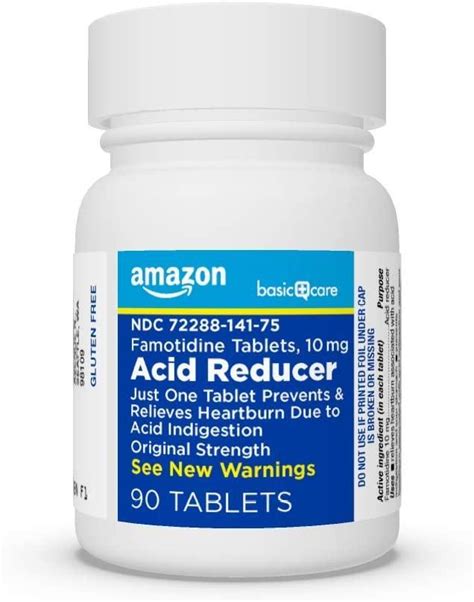
Famotidine belongs to a class of medications known as histamine-2 (H2) blockers. These medications work by inhibiting the action of histamine, a chemical that stimulates the production of stomach acid. By blocking the histamine receptors in the stomach, famotidine reduces the amount of acid produced, thereby alleviating symptoms of heartburn, acid reflux, and other related conditions. The medication is available in various forms, including tablets, capsules, and injectable solutions, making it accessible to a wide range of patients. Famotidine's working mechanism is complex, involving the inhibition of histamine receptors and the subsequent reduction of stomach acid production.
Benefits of Famotidine
The benefits of famotidine are numerous, and its effectiveness has been demonstrated in various clinical trials. Some of the key benefits of famotidine include: * Relief from heartburn and acid reflux symptoms * Healing of esophageal damage caused by acid reflux * Prevention of gastrointestinal bleeding in patients at risk * Treatment of Zollinger-Ellison syndrome and other conditions characterized by excessive stomach acid production * Mild side effects compared to other medicationsTypes of Famotidine
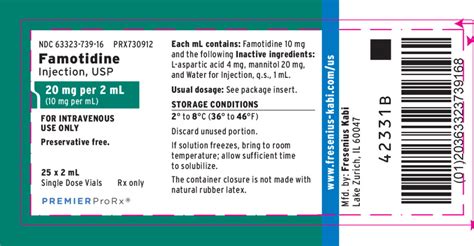
Famotidine is available in various forms, including:
- Oral tablets and capsules
- Injectable solutions
- Liquid suspensions
- Combination products with other medications, such as antacids or pain relievers Each type of famotidine has its own set of benefits and drawbacks, and the choice of formulation depends on the individual patient's needs and medical history.
Side Effects of Famotidine
While famotidine is generally well-tolerated, it can cause some side effects, including: * Headache * Dizziness * Constipation * Diarrhea * Nausea and vomiting * Abdominal pain * Rash or itching It is essential to note that these side effects are usually mild and temporary, and they may subside on their own or with treatment.Famotidine Dosage and Administration
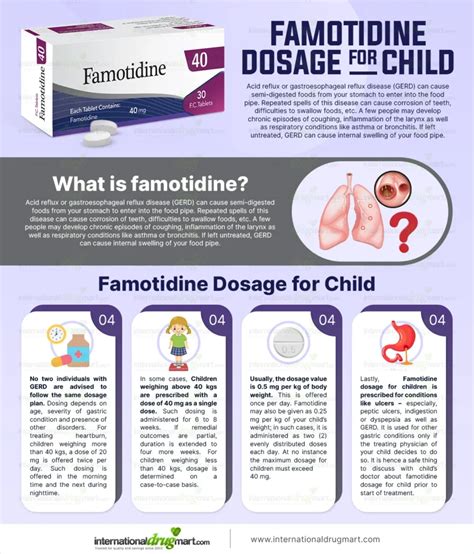
The dosage and administration of famotidine depend on the individual patient's needs and medical history. The typical dosage range for famotidine is:
- 20-40 mg per day for the treatment of heartburn and acid reflux
- 40-80 mg per day for the treatment of Zollinger-Ellison syndrome and other conditions characterized by excessive stomach acid production
- 20-40 mg per day for the prevention of gastrointestinal bleeding in patients at risk It is essential to follow the recommended dosage and administration instructions to ensure the safe and effective use of famotidine.
Interactions with Other Medications
Famotidine can interact with other medications, including: * Antacids * Pain relievers * Blood thinners * Diabetes medications * Thyroid medications It is essential to inform healthcare professionals about all medications being taken, including prescription and over-the-counter medications, to minimize the risk of interactions.Famotidine and Pregnancy

Famotidine is generally considered safe to use during pregnancy, but it is essential to consult healthcare professionals before taking any medication. The medication has been shown to cross the placenta, but it is not known to cause harm to the fetus. However, as with any medication, it is crucial to weigh the benefits and risks of using famotidine during pregnancy.
Breastfeeding and Famotidine
Famotidine is excreted in breast milk, but it is not known to cause harm to the baby. However, as with any medication, it is essential to consult healthcare professionals before taking famotidine while breastfeeding. The benefits and risks of using famotidine during breastfeeding should be carefully considered, and alternative treatments may be recommended if necessary.Famotidine and Children
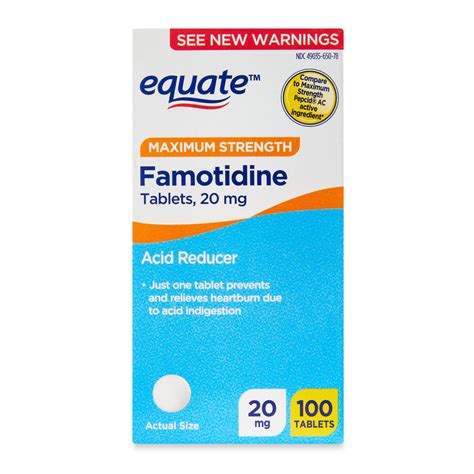
Famotidine is not recommended for use in children under the age of 12, as its safety and efficacy in this age group have not been established. However, in some cases, healthcare professionals may prescribe famotidine for children with severe gastrointestinal conditions. It is essential to follow the recommended dosage and administration instructions and to monitor the child's response to the medication closely.
Geriatric Use of Famotidine
Famotidine is generally well-tolerated in older adults, but it may cause some side effects, such as confusion, dizziness, and headache. The medication should be used with caution in older adults, and the dosage should be adjusted according to the individual's needs and medical history.Famotidine Overdose
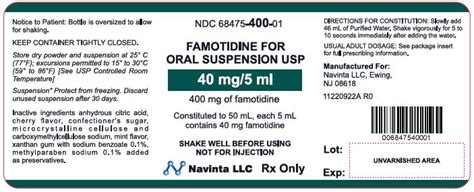
Famotidine overdose can cause severe side effects, including:
- Confusion
- Dizziness
- Headache
- Abdominal pain
- Nausea and vomiting
- Diarrhea
- Rash or itching If an overdose is suspected, it is essential to seek medical attention immediately.
Famotidine Withdrawal
Famotidine is not known to cause physical dependence or withdrawal symptoms. However, it is essential to follow the recommended dosage and administration instructions and to consult healthcare professionals before stopping the medication.What is famotidine used for?
+Famotidine is used to treat various gastrointestinal conditions, including heartburn, acid reflux, and Zollinger-Ellison syndrome.
How does famotidine work?
+Famotidine works by inhibiting the production of stomach acid, thereby alleviating symptoms of heartburn, acid reflux, and other related conditions.
What are the side effects of famotidine?
+Famotidine can cause side effects, including headache, dizziness, constipation, diarrhea, nausea, and abdominal pain.
Can I take famotidine during pregnancy?
+Famotidine is generally considered safe to use during pregnancy, but it is essential to consult healthcare professionals before taking any medication.
Can I breastfeed while taking famotidine?
+Famotidine is excreted in breast milk, but it is not known to cause harm to the baby. However, it is essential to consult healthcare professionals before taking famotidine while breastfeeding.
In conclusion, famotidine is a medication that has been widely used to treat various gastrointestinal conditions. Its ability to reduce stomach acid production and alleviate symptoms of heartburn, acid reflux, and other related conditions has made it a trusted treatment option for healthcare professionals and patients alike. By understanding the benefits, working mechanisms, and potential side effects of famotidine, individuals can make informed decisions about their treatment options and take a proactive approach to managing their gastrointestinal health. We invite you to share your thoughts and experiences with famotidine in the comments section below and to explore other articles on our website for more information on gastrointestinal health and wellness.
